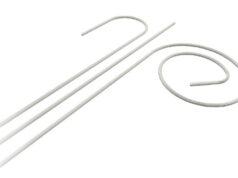The Corindus CorPath system, a robotic catheter manipulation platform, was discussed by Dr Peter Fitzgerald, Center for Cardiovascular Technology, Stanford University Medical Center, CA, at the TCT meeting in October.
He presented a small pilot study conducted with the CorPath system, which had good clinical results. He believes the benefits of using a robotic system such as this include reduced inter-operator variability and increased safety for physicians and that in the future this technology could be used for the treatment of electrophysiological problems.
Pilot study
The pilot study enrolled 19 patients and had primary endpoints of in-hospital MACE and 30-day MACE. A single lesion in each patient was treated with a guidewire, balloon and stent, using the CorPath system. Patients were on average 55 years old, 16 were male and three female. Five patients were diabetic and 13 had a history of smoking, with eight previously suffering from myocardial infarction. No MACE were reported in-hospital and there was one incident at 30 days (non-target vessel). Clinical success was reportedly 100%, with device success with the wire 95% (18/19 patients) and device success with the stent 83% (15/19 patients). Procedure time was recorded in 17 of the cases and total catherisation times were on average 44 minutes (***plus or minus*** 32.7) and total fluoroscopy time was 8.8 minutes (***plus or minus*** 4.8).
A beta study on the CorPath found similar results. Enrolling 11 patients, the in-hospital and 30-day MACE was 0%, with 100% clinical success and wire success, and 81.8% stent success.
System design
The CorPath system, which is compatible with existing imaging systems, is designed to aid interventionalists by allowing for remote procedures that can be performed from the control room of the cath lab. The setup allows for procedures to be performed remotely from either inside the room or from the control room of the cath lab. This is enabled by the system components, a bedside unit and a physician workstation. The bedside unit can be mounted on the side bar of all standard catheterisation procedure tables and swings into position over the patient’s femoral access site. Devices can be manoeuvred rotationally, axially, or simultaneously. The patient console houses the sterile cassette and allows for the mechanical movement of devices, while the motion is controlled by the physician at the workstation.
The device is manoeuvred using a joystick and touch screen. Axial and rotational guidewire motions are achieved by exchanging a torqueing device in the physician’s hand for a joystick that has similar characteristics and transmits hand movements through mechanical transmission to the CorPath robotic arm. There are also options for continuous mode and discrete-step wire rotations and precise balloon/stent placement to within 0.5mm on the touch screen. The design includes a feature that locks the guidewire in position when the balloon/stent is being manipulated, and vice versa.
Targets in electrophysiology
Specifically addressing the issue of heart rhythm, Fitzgerald believes that atrial fibrillation could be treated with robotic manipulation systems, in part due to the inadequacy of current therapies such as Maze open surgery or catheter ablation.
Fitzgerald notes that as well as the increased precision and standardisation of results achieved by reducing the variability between operators, there is a benefit to the physician in terms of health and safety: a reduction in exposure to radiation and spinal problem brought about by wearing heavy lead aprons, now that close proximity to the patient is no longer required. He adds that this type of technology will be intuitive for “30-year-olds, the next generation,” who are familiar with computer gaming and the use of a joystick for continuous movement.
Concluding, Fitzgerald posited that the future clinical applications of robotic catheter manipulation could include complex cases such as chronic total occlusion or birfurcation; peripheral vessel stenting; treatment of electrophysiological problems; carotid interventions; and valve placement.












